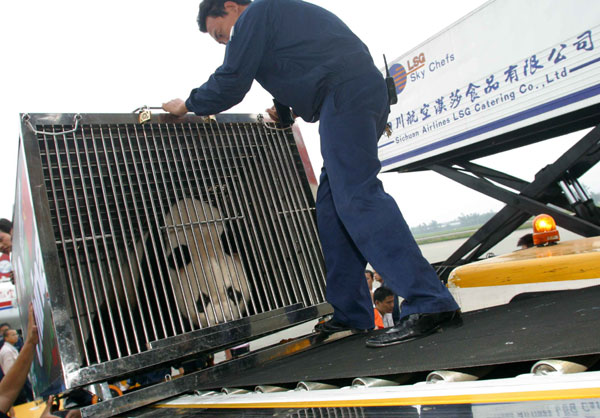
Hua Zuiba begins a 30-hour journey to Spain in 2007. It took her several months to relax in her new home.(Photo: China Daily)
Making the transition
To help the pandas adapt to their new environment more swiftly and smoothly, Chinese expertsescort them to their new countries and teach local keepers and veterinarians how to raisecaptive pandas in a simulated wild environment.
It wasn't an easy transition for Wang Wang and Funi, who left Bifengxia for Adelaide Zoo in SouthAustralia in November 1999. They had just developed extra fur for a Ya'an winter, when theaverage temperature is 5 degrees Celsius. In Adelaide, however, it was summer and 35 C onaverage. The pandas' thick coats prevented them from cooling easily.
During their first month, the pandas stayed all day inside, where the temperature was controlledat 18-20 C. The next month, keepers opened the enclosure door for a half-hour each day toencourage the pandas to go outside and get familiar with the new environment.
In a week, Wang Wang caught cold. He had a runny nose, lost his appetite and ran a fever ashigh as 38.9 C (normal is 37). Veterinarians diagnosed him with mild pneumonia and gave himmedication. He recovered two days later.
Adelaide is Australia's driest state capital, with an annual average rainfall of just 549 mm, compared with more than 1,800 mm for Ya'an. It has only a couple of types of bamboo, whichWang Wang and Funi do not quite enjoy.
To meet their dietary requirements, Adelaide Zoobegan to fly in bamboo every week from Queensland in northeast Australia, according to Luo Bo, who took the pandas from Ya'an to Adelaide. The zoo also has a 14-hectare browse plantation atBolivar, a northern suburb of Adelaide.
Homegrown supply
All of the zoos that receive pandas from China have found bamboo supplies in their own ornearby countries. At the US' National Zoo in Washington, each panda is fed about 23 kg ofbamboo a day. Most of what they eat is grown on a farm in southern Maryland in the US.
"These countries do not import bamboo from China mainly because long-distance transportationexpenses remain high," said Luo, who is deputy director of panda husbandry at ChinaConservation and Research.
"Besides, it is hard to preserve fresh bamboo during the trip. Not to mention that it usually takesone or two months for living plants like bamboo to go through the quarantine procedure beforethey are allowed for exportation."
The Edinburgh Zoo expects Tian Tian and Yang Guang to consume nearly 18,000 kg of bambooevery year, or about 20 three-meter stems each day.
Initially, German grower Reiner Winkendick is providing 85 percent of the animals' requirementwith bamboo he produces at a nursery on the outskirts of Amsterdam. The rest is grown atspecial sites around the zoo. After three years, the zoo will increase its homegrown supply.

Copyright ©1999-2011 Chinanews.com. All rights reserved.
Reproduction in whole or in part without permission is prohibited.